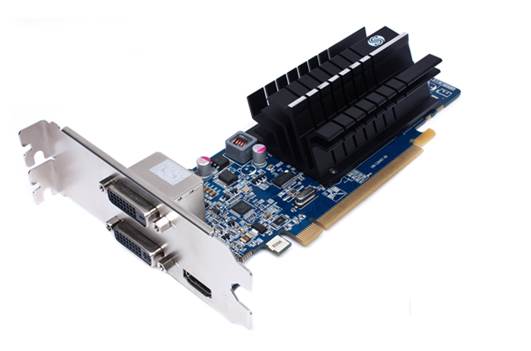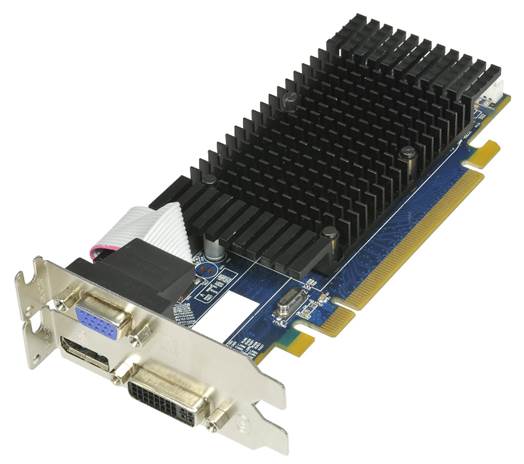SapphireRadeon HD 6450 FleX
It might be starting to show its age a
little, but the Sapphire Radeon HD 6450 FleX is still a decent card that offers
a substantial boost up from most integrated GPUs. As well as being a silent,
passive-cooling only card, the HD 6450 FleX is also low profile. While it does
need two slots to accommodate the heatsink, it's actually incredibly compact -
if your system is pushed for space, internally, you shouldn't have any trouble
getting this to fit inside.
It's worth noting that the point of
Sapphire's FleX cards isn't necessarily gaming, but multi-monitor systems. This
model supports three monitors on DVI (two on DVI ports and one on a DVI-HDMI
converter). If you want to add multiple screens to a system, this card - even
though it's starting to age - is more than capable of accommodating them,
whether in an office or multimedia situation. In this case, the lack of active
cooling makes sense: it means there's less of a distraction while you working,
and less drone noise competing with the movie or TV show you want to watch.

SapphireRadeon
HD 6450 FleX
Although it isn't a gaming beast, it does
at least support DirectX 11, which makes it feel like part of the modern
generation of cards even if it's a few iterations behind the best. Don't expect
to run games in high resolutions, or detail, but you can expect better than
your integrated GPU in most cases. The notable exception is if you've got a
high-end Ivy Bridge CPU, because the card is only a shade better than the Intel
HD Graphics 4000 GPUs - but then if you've got a processor with that, you'd
probably want a better graphics card than this anyway.
The only area that really lets it down is
the price. At around $70, it comes in a tenner more expensive than
active-cooled versions of the HD 6450, which is a high percentage when you're
operating at prices this low. However, it's a solid performer with some unique
features, so it's definitely got a niche - and that gives it a good reason to
be considered.
DETAILS
·
Price: $70
·
Architecture: Caicos (40nm)
·
Memory:1GB DDR3
Asus GeForce GT 620 DirectCU Silent
Like the GeForce GT 610, the GT 620 isn't a
6-series Kepler card, but a rebranded 5-series in disguise. In this case, it's
a GT 530 with a slightly better TDP and more CUDA cores. Not, on the surface, a
huge amount to get excited about. However, sandwiched (price-wise, at least)
between the multi-monitor focused Sapphire Radeon HD 6450 FleX and the
form-over-function HIS Radeon HD 5450 Silence, the GT630 Silent actually takes
on a decent level of appeal.
It's substantially better than an Intel HD
Graphics 4000 chip, which is something no cheaper card can claim, and which
even some more expensive cards can't boast. That, in turn, means it'll
represent an upgrade to the graphics capabilities of any system you put it in,
provided that system doesn't already have a graphics card and isn't an AMD A10
APU, which have an integrated graphics chip that's slightly better. It may not
necessarily a huge upgrade, but it will definitely be one. That's something
worth paying attention to.

Asus
GeForce GT 620 DirectCU Silent
Output ports include one VGA, one DVI and one
HDMI. The 2GB of memory is prodigious, but not necessarily much of a
performance improvement at this level - the card is restricted by its memory
bus anyway, rather than the amount of RAM in it.
There are certainly better silent cards
around, but the GT 620 does fit comfortably into the mid-range. It's powerful
enough to improve any system, better than some more expensive cards, and to get
one that's definitively better you have to spend nearly double the amount.
All of that makes this a smart buy for anyone
who doesn't want to spent much more than $$78.8 on a graphics upgrade. It's
still far from a competitive gaming card, but an improvement is an improvement.
If you're on a fairly tight budget, this is the one to aim for.
DETAILS
·
Price: $79
·
Architecture: Fermi (40nm)
·
Memory: 2GB DDR3
HIS Radeon HD 5450 Silence
Despite being released after the arrival of
the Radeon HD 6000 series, the HIS Radeon HD 5450 Silence was never designed to
be a high-end card. Rather, the emphasis was always on silent running. With
that in mind, we can forgive its aging architecture, and instead praise its
innovations - and unlike some cards in this guide, this one does have some.
Specifically, we're impressed by the
selection of brackets offered with the card. You get a dual-slot bracket with
DVI, Display Port and VGA, a singles lot bracket with the same, and a
half-height brackets with just DVI and Display Port. Although there's no
dedicated HDMI port, the box does include a DVI to HDMI adaptor. Some versions
also use a PCI-Ex1 connector.

HIS
Radeon HD 5450 Silence
So while its performance isn't great (the
HD 5450 is about as good as Intel HD Graphics 3000), the extras it offers do
give you a reason to buy one as long as performance isn't a huge concern.
Cheaper cards will perform better, but they don't have the support and
adaptability of the HIS HD 5450 Silence, and adaptability is sure to matter if
you're building an unconventional system. Buy the version with PCI-E x1 support
and it'll fits in thin and compact systems, such as the Dell Optiplex 745.
By circumventing the games market - the
normal preoccupation of graphics cards manufacturers - HIS has somehow managed
to come up with a card that sells itself despite a lack of raw power. There are
plenty of systems out there that would get a upgrade if this card was put into
them, and it's even substantially cheaper than buying a sandy bridge chip and
motherboard, which would get you to the same level.
This is clearly the sort of card that knows
its audience, so while we're wary of recommending it outright due to its high
price/ low power combination, it's pretty clear that if you're the sort of
person looking for a card like this, nothing we say can (or should) stop you.
If you're not one of those people - and you'd know if you were - then you can
otherwise safely ignore it in favor of something cheaper and more powerful.
DETAILS
·
Price: $90
·
Architecture: Cedar Pro (40nm)
·
Memory: 1GB DDR3